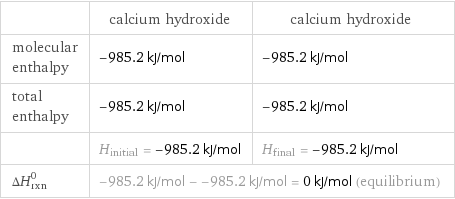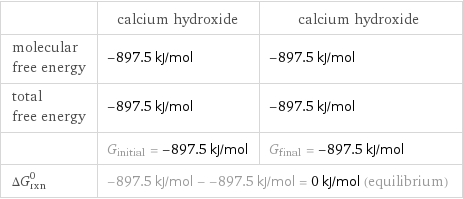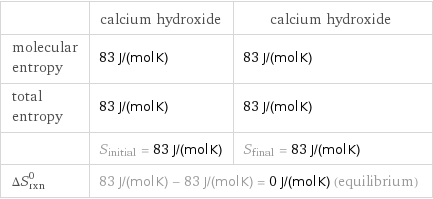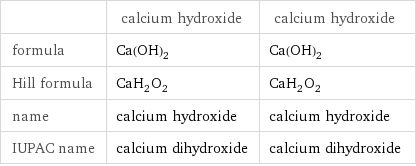Input interpretation

Ca(OH)_2 calcium hydroxide ⟶ Ca(OH)_2 calcium hydroxide
Balanced equation

Balance the chemical equation algebraically: Ca(OH)_2 ⟶ Ca(OH)_2 Add stoichiometric coefficients, c_i, to the reactants and products: c_1 Ca(OH)_2 ⟶ c_2 Ca(OH)_2 Set the number of atoms in the reactants equal to the number of atoms in the products for Ca, H and O: Ca: | c_1 = c_2 H: | 2 c_1 = 2 c_2 O: | 2 c_1 = 2 c_2 Since the coefficients are relative quantities and underdetermined, choose a coefficient to set arbitrarily. To keep the coefficients small, the arbitrary value is ordinarily one. For instance, set c_1 = 1 and solve the system of equations for the remaining coefficients: c_1 = 1 c_2 = 1 Substitute the coefficients into the chemical reaction to obtain the balanced equation: Answer: | | Ca(OH)_2 ⟶ Ca(OH)_2
Structures

⟶
Names

calcium hydroxide ⟶ calcium hydroxide
Reaction thermodynamics
Enthalpy

| calcium hydroxide | calcium hydroxide molecular enthalpy | -985.2 kJ/mol | -985.2 kJ/mol total enthalpy | -985.2 kJ/mol | -985.2 kJ/mol | H_initial = -985.2 kJ/mol | H_final = -985.2 kJ/mol ΔH_rxn^0 | -985.2 kJ/mol - -985.2 kJ/mol = 0 kJ/mol (equilibrium) |
Gibbs free energy

| calcium hydroxide | calcium hydroxide molecular free energy | -897.5 kJ/mol | -897.5 kJ/mol total free energy | -897.5 kJ/mol | -897.5 kJ/mol | G_initial = -897.5 kJ/mol | G_final = -897.5 kJ/mol ΔG_rxn^0 | -897.5 kJ/mol - -897.5 kJ/mol = 0 kJ/mol (equilibrium) |
Entropy

| calcium hydroxide | calcium hydroxide molecular entropy | 83 J/(mol K) | 83 J/(mol K) total entropy | 83 J/(mol K) | 83 J/(mol K) | S_initial = 83 J/(mol K) | S_final = 83 J/(mol K) ΔS_rxn^0 | 83 J/(mol K) - 83 J/(mol K) = 0 J/(mol K) (equilibrium) |
Equilibrium constant
![Construct the equilibrium constant, K, expression for: Ca(OH)_2 ⟶ Ca(OH)_2 Plan: • Balance the chemical equation. • Determine the stoichiometric numbers. • Assemble the activity expression for each chemical species. • Use the activity expressions to build the equilibrium constant expression. Write the balanced chemical equation: Ca(OH)_2 ⟶ Ca(OH)_2 Assign stoichiometric numbers, ν_i, using the stoichiometric coefficients, c_i, from the balanced chemical equation in the following manner: ν_i = -c_i for reactants and ν_i = c_i for products: chemical species | c_i | ν_i Ca(OH)_2 | 1 | -1 Ca(OH)_2 | 1 | 1 Assemble the activity expressions accounting for the state of matter and ν_i: chemical species | c_i | ν_i | activity expression Ca(OH)_2 | 1 | -1 | ([Ca(OH)2])^(-1) Ca(OH)_2 | 1 | 1 | [Ca(OH)2] The equilibrium constant symbol in the concentration basis is: K_c Mulitply the activity expressions to arrive at the K_c expression: Answer: | | K_c = ([Ca(OH)2])^(-1) [Ca(OH)2] = ([Ca(OH)2])/([Ca(OH)2])](../image_source/4b9928eb0b32ca7baa84981e6779900b.png)
Construct the equilibrium constant, K, expression for: Ca(OH)_2 ⟶ Ca(OH)_2 Plan: • Balance the chemical equation. • Determine the stoichiometric numbers. • Assemble the activity expression for each chemical species. • Use the activity expressions to build the equilibrium constant expression. Write the balanced chemical equation: Ca(OH)_2 ⟶ Ca(OH)_2 Assign stoichiometric numbers, ν_i, using the stoichiometric coefficients, c_i, from the balanced chemical equation in the following manner: ν_i = -c_i for reactants and ν_i = c_i for products: chemical species | c_i | ν_i Ca(OH)_2 | 1 | -1 Ca(OH)_2 | 1 | 1 Assemble the activity expressions accounting for the state of matter and ν_i: chemical species | c_i | ν_i | activity expression Ca(OH)_2 | 1 | -1 | ([Ca(OH)2])^(-1) Ca(OH)_2 | 1 | 1 | [Ca(OH)2] The equilibrium constant symbol in the concentration basis is: K_c Mulitply the activity expressions to arrive at the K_c expression: Answer: | | K_c = ([Ca(OH)2])^(-1) [Ca(OH)2] = ([Ca(OH)2])/([Ca(OH)2])
Rate of reaction
![Construct the rate of reaction expression for: Ca(OH)_2 ⟶ Ca(OH)_2 Plan: • Balance the chemical equation. • Determine the stoichiometric numbers. • Assemble the rate term for each chemical species. • Write the rate of reaction expression. Write the balanced chemical equation: Ca(OH)_2 ⟶ Ca(OH)_2 Assign stoichiometric numbers, ν_i, using the stoichiometric coefficients, c_i, from the balanced chemical equation in the following manner: ν_i = -c_i for reactants and ν_i = c_i for products: chemical species | c_i | ν_i Ca(OH)_2 | 1 | -1 Ca(OH)_2 | 1 | 1 The rate term for each chemical species, B_i, is 1/ν_i(Δ[B_i])/(Δt) where [B_i] is the amount concentration and t is time: chemical species | c_i | ν_i | rate term Ca(OH)_2 | 1 | -1 | -(Δ[Ca(OH)2])/(Δt) Ca(OH)_2 | 1 | 1 | (Δ[Ca(OH)2])/(Δt) (for infinitesimal rate of change, replace Δ with d) Set the rate terms equal to each other to arrive at the rate expression: Answer: | | rate = -(Δ[Ca(OH)2])/(Δt) = (Δ[Ca(OH)2])/(Δt) (assuming constant volume and no accumulation of intermediates or side products)](../image_source/16d1a9f9ecc82391ee3b4be3ce7486bb.png)
Construct the rate of reaction expression for: Ca(OH)_2 ⟶ Ca(OH)_2 Plan: • Balance the chemical equation. • Determine the stoichiometric numbers. • Assemble the rate term for each chemical species. • Write the rate of reaction expression. Write the balanced chemical equation: Ca(OH)_2 ⟶ Ca(OH)_2 Assign stoichiometric numbers, ν_i, using the stoichiometric coefficients, c_i, from the balanced chemical equation in the following manner: ν_i = -c_i for reactants and ν_i = c_i for products: chemical species | c_i | ν_i Ca(OH)_2 | 1 | -1 Ca(OH)_2 | 1 | 1 The rate term for each chemical species, B_i, is 1/ν_i(Δ[B_i])/(Δt) where [B_i] is the amount concentration and t is time: chemical species | c_i | ν_i | rate term Ca(OH)_2 | 1 | -1 | -(Δ[Ca(OH)2])/(Δt) Ca(OH)_2 | 1 | 1 | (Δ[Ca(OH)2])/(Δt) (for infinitesimal rate of change, replace Δ with d) Set the rate terms equal to each other to arrive at the rate expression: Answer: | | rate = -(Δ[Ca(OH)2])/(Δt) = (Δ[Ca(OH)2])/(Δt) (assuming constant volume and no accumulation of intermediates or side products)
Chemical names and formulas

| calcium hydroxide | calcium hydroxide formula | Ca(OH)_2 | Ca(OH)_2 Hill formula | CaH_2O_2 | CaH_2O_2 name | calcium hydroxide | calcium hydroxide IUPAC name | calcium dihydroxide | calcium dihydroxide
Substance properties

| calcium hydroxide | calcium hydroxide molar mass | 74.092 g/mol | 74.092 g/mol phase | solid (at STP) | solid (at STP) melting point | 550 °C | 550 °C density | 2.24 g/cm^3 | 2.24 g/cm^3 solubility in water | slightly soluble | slightly soluble odor | odorless | odorless
Units
